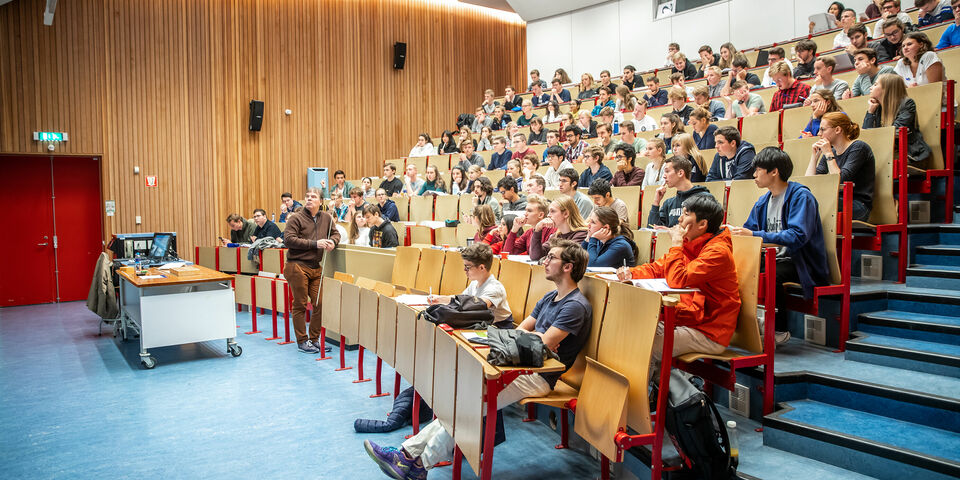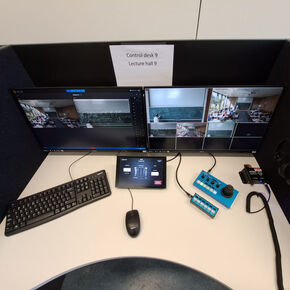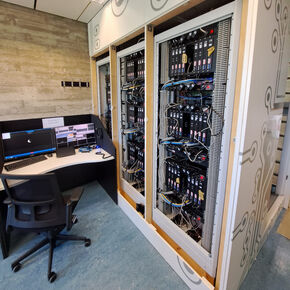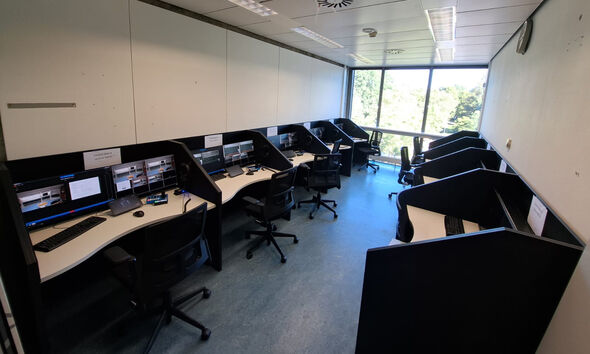New AV facilities at the Auditorium
Over the summer recess, the Auditorium was given a significant make-over with regard to its audiovisual means. All rooms were equipped with the latest technology and the control room was expanded, making it possible to stream lectures from all rooms at the same time. This week also saw the start of a pilot on a new technology that allows for the digital conversion of handwritten notes on the chalkboard.
If you have any questions about audiovisual (AV) facilities at TU/e, the person to ask them to is Robert van Ginkel, AV Product Owner at the Hybrid Education & Audiovisual Support (HEAVS) product team. “This may sound complicated, but it comes down to me being the first point of contact for the entire organization for anything involving audiovisual means, both in meeting and teaching rooms,” he says. “Our multidisciplinary team consisting of ten people runs the audiovisual ambit at TU/e. This multidisciplinary team arose from the TaskForce AV, in which ESA, RE, FMC, EduB and the departments are represented.”
Control room
Cursor asked him what changes the Auditorium underwent; it turns out there are many. “Already before the summer recess we fully refurbished the Blauwe Zaal and the Senaatszaal, replacing all technology because it was at the end of its technical lifespan,” Van Ginkel plunges into the story. “In so doing, we of course tried to integrate all kinds of new things. Not so much new in the sense of new functionality, but in the sense of better and more efficient technology.”
The other sixteen rooms in the Auditorium – eight upstairs and eight downstairs – were also in need of renovation. “There we replaced all of the technology over the summer,” he continues. An added request from the Education Board was to expand the streaming facilities. “All rooms already had the right technology – cameras and audio systems – to stream lectures, but we could only do it for eight lecture rooms at a time.”
The streaming technology is operated from the control room at the top of the Auditorium, not far from the Cursor editorial office. “Over the summer recess AV Support, which was next door, was relocated so the control room could be expanded. Its capacity was scaled up to sixteen control positions, making it possible to stream lectures from all rooms at the same time.”
Independent AV network
The Auditorium also got its own network for AV, Van Ginkel tells us. “If you let audio and video flow through a standard IT network, this puts the network under so much pressure that it may be at the detriment of another service. Or, conversely, it may happen that audio and video signals are interrupted when the network is overburdened, for instance because the number of outgoing emails spikes too high. This is why, in consultation with the LIS network team, we chose to create our own AV network here in the Auditorium,” he explains. The new AV network is completely independent, and therefore less susceptible to disruption.
Sometimes, however, one cannot get around connecting the Auditorium network to that of the rest of the campus, for example when an event at the Auditorium is being livestreamed via the TU/e website. But this won’t be causing any more overloads either, because the technology of the Auditorium network has been modified. “Traditionally, AV devices were directly connected to one another. By using AV over IP, it’s possible to control the audio and video signals by way of smart switching points, making us more flexible and scalable without placing a burden on the rest of the TU/e network,” Van Ginkel explains.
The new network has another advantage: “It has made it easier to link rooms to each other.”. This is mostly relevant when the number of students exceeds the capacity of a lecture room. By linking the rooms and sending the video signal from one room to another, the surplus group of students can follow the lecture from a different room. “This was already possible, but now it has become even easier,” says van Ginkel.
From chalk to digital
This week also saw the launch of a pilot on a new technology in the upstairs rooms of the Auditorium. Chalkboards are still used a lot on campus, Van Ginkel tells us. “Many teachers manage fine with modern means such as whiteboards and smartboards, but there’s also a group that’s used to chalkboards and wants to keep using them, for example for lengthy math formulas.” In an effort to cater to this group of teachers as well, over the summer new technology was installed in the upstairs rooms, which allows for the digital conversation of handwritten notes on the chalkboard.
“Cameras are generally placed in the back of the room, so when you’re streaming a lecture the notes on chalkboards are often insufficiently legible,” he explains. “That is why we added an extra camera and purchased special software that filters out the teacher and digitizes anything that’s written on the chalkboard.” This means students are not only receiving the video recordings, but also the digital notes, increasing their awareness of what’s happening in the lecture room.
“This technology isn’t being used at Dutch universities all that much yet, so we’re pretty proud of it and hope it provides an extra service to our students,” says Van Ginkel. As the notes are also saved, they remain available after the teacher has erased them from the board. “This makes it a valuable addition to both lecture livestreams and recordings.”
The pilot will be evaluated after the first quarter. “To this end we’ll talk to the teachers, but also send out surveys to the students. After all, they are the end users we are trying to cater to,” he tells us. “And then we’re going to look into rolling out the technology to other lecture rooms.”
Hybrid education
These innovations bring the university a step closer to its ultimate goal: creating fully hybrid classrooms that make it possible to attend lectures both in a physical space and online, while offering the same quality and interaction opportunities. “The internationalization of education and EWUU and EuroTeQ alliances, but also lifelong learning and Challenge-Based Learning, are creating a growing need to facilitate distance teaching,” Van Ginkel asserts. “That’s why we are currently taking stock of the rooms we’ll be equipping with technology in the coming period. Which technology should we choose and which rooms should become fully hybrid? We look closely at what’s needed and what fits the budget.”
He admits that for the moment, it’s a pipe dream to make all teaching and meeting rooms fully hybrid. But great progress is being made in the area. “Audiovisual facilities are important in improving the quality of education,” he concludes.






Discussion